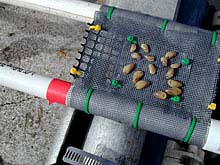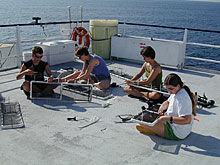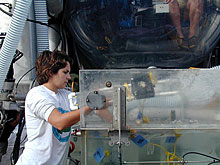
Baby mussels glued to window screen mesh are part of an experiment to see which part of the mussel bed they can live on without getting eaten. These mussels are less than one centimeter long. Click image for a larger view.
October 11, 2002
Shawn Arellano
University of Oregon
Day 4 was a full day of diving at the Brine Pool. Three dives were devoted to deploying experiments on larval recruitment of the Brine Pool mussels, Bathymodiolus childressii. Ever since the Brine Pool was discovered, scientists have noticed that the sizes of mussels at the edge of the Brine Pool are very different from those at the outer edge of the mussel bed. Most of the mussels near the brine are small and at certain times of the year, there seems to be a ring of baby mussels just around the edge of the pool. On the outer edge of the mussel bed, the mussels are very large and there are many empty shells. Scientists assume that mussels, whose larvae swim around in the water column and feed, preferentially settle at the inner edge of the Brine Pool because there are higher levels of methane there. However, we do not know why the mussels seem to prefer the inner edge of the pool. Do the mussel larvae sense the methane or oxygen there? Do they sense the presence of other small mussels? Or maybe they settle all over the mussel bed, but the babies at the outer edge of the mussel bed don’t survive because the conditions are bad or because they get eaten by predators. The experiments that were deployed on today’s dives will try to answer these questions.

Scientists Ana Hilario, Isabel Tarjuelo, Shawn Arellano and Linda Seldeck enjoy the sun on the upper deck of the Seward Johnson II while building an experiment to test larval settlement preferences of brine-pool mussels. Click image for larger view.
A crew of scientists spent the last two days building the two experiments we deployed today. The first experiment was to test settlement preferences of the mussel larvae. We built pvc and plastic mesh cages that contained large and small dead mussel shells and large and small live mussels. These cages were deployed near the inner edge of the Brine Pool, at the outer edge of the mussel bed, and about two meters away from the outside of the mussel bed. In addition, Dr. Tobias has put devices on the cages that will sample the water chemistry at each site. In February 2003, we will go back to the Brine Pool to recover these settlement trays and count the baby mussels that have settled on them. If the experiment is successful, it will show us what sort of habitat the mussel larvae prefer.

Shawn Arellano places her mussel predation trays into the Biobox on the Johnson-Sea-Link submersible. Because the mussels are alive, they have to be kept in cold water on their way down to the Brine Pool. Click image for a larger view.
The second experiment will tell us if young mussels can survive away from the inner edge of the Brine Pool. We put some baby mussels inside cages to keep out predators like crabs, fish, sea stars, and snails, and left others outside the cages so that predators could get them. When we come back to get them in February, we will be able to see where on the mussel bed the babies mussels can survive.
Sign up for the Ocean Explorer E-mail Update List.























